SBS Swiss Business School MIS 220 Finals: Essay Questions Analysis
VerifiedAdded on 2021/06/22
|19
|3486
|127
Homework Assignment
AI Summary
This document presents a comprehensive solution to the MIS 220 finals assignment from SBS Swiss Business School, focusing on Management Information Systems. The assignment includes detailed essay questions and answers covering core concepts such as Database Management Systems (DBMS), exploring their advantages and disadvantages. It delves into cloud computing, explaining its components, cloud models, and service models like SaaS, IaaS, and PaaS. Furthermore, the assignment addresses the role of MIS in contemporary business, highlighting its contribution to operational excellence and competitive advantage. It also analyzes the evolution of the web, from Web 1.0 to Web 2.0 and beyond. The solution also provides insights on General Data Protection Regulation and Database System Architectures & Data Model Management. This assignment provides a thorough understanding of key MIS topics and their practical applications in today's business environment.
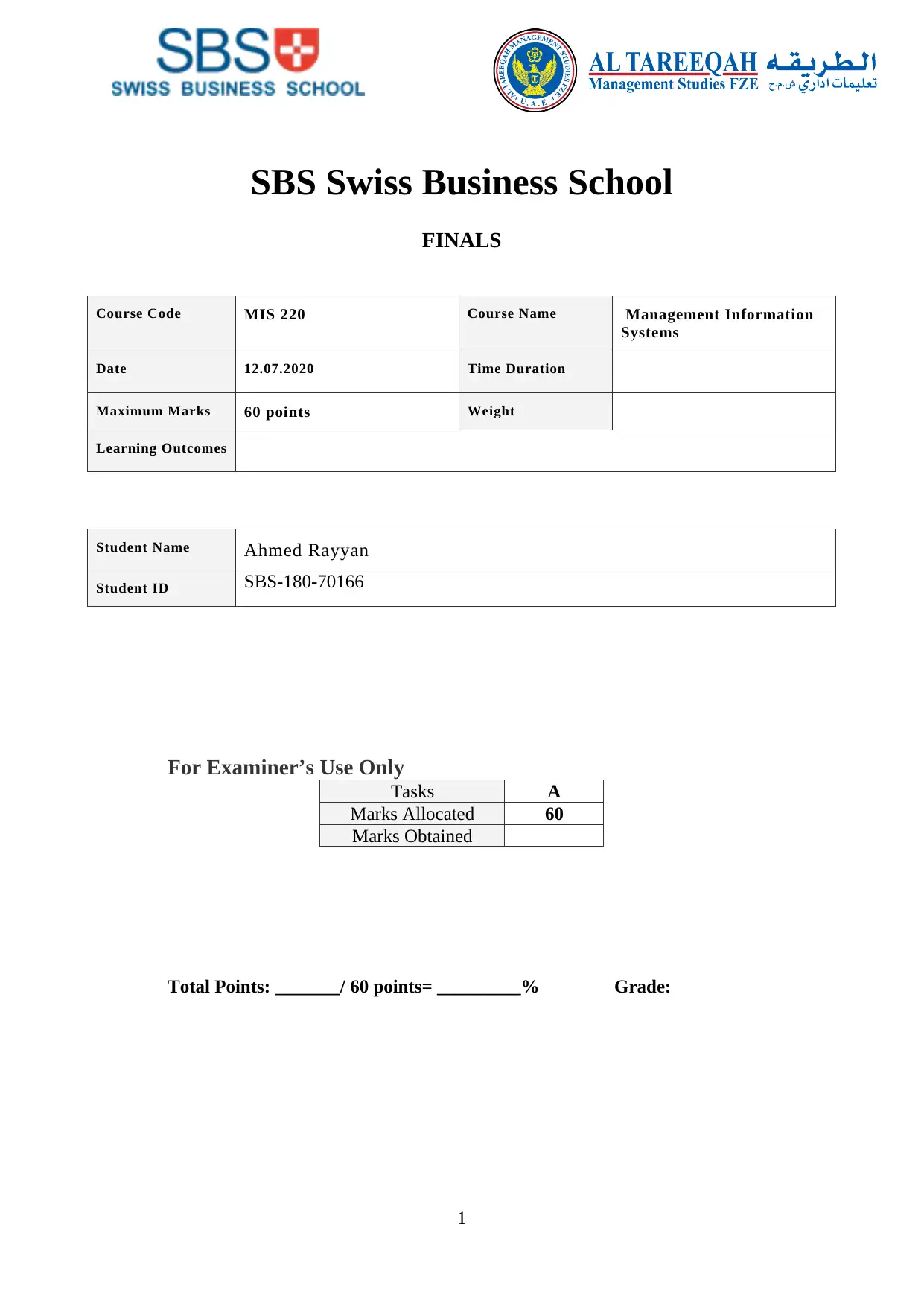
SBS Swiss Business School
FINALS
Course Code MIS 220 Course Name Management Information
Systems
Date 12.07.2020 Time Duration
Maximum Marks 60 points Weight
Learning Outcomes
Student Name Ahmed Rayyan
Student ID SBS-180-70166
For Examiner’s Use Only
Tasks A
Marks Allocated 60
Marks Obtained
Total Points: _______/ 60 points= _________% Grade:
1
FINALS
Course Code MIS 220 Course Name Management Information
Systems
Date 12.07.2020 Time Duration
Maximum Marks 60 points Weight
Learning Outcomes
Student Name Ahmed Rayyan
Student ID SBS-180-70166
For Examiner’s Use Only
Tasks A
Marks Allocated 60
Marks Obtained
Total Points: _______/ 60 points= _________% Grade:
1
Paraphrase This Document
Need a fresh take? Get an instant paraphrase of this document with our AI Paraphraser
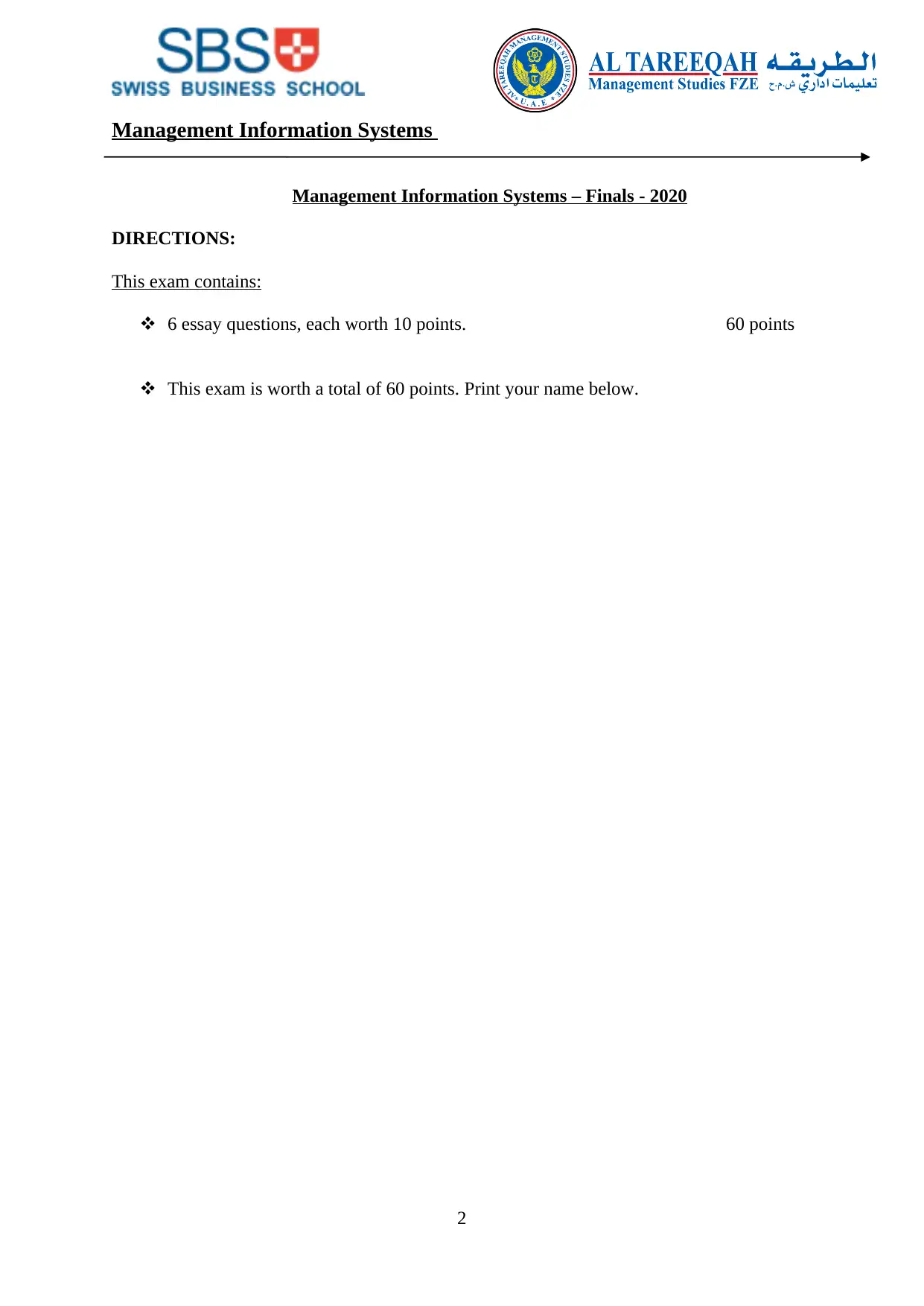
Management Information Systems
Management Information Systems – Finals - 2020
DIRECTIONS:
This exam contains:
6 essay questions, each worth 10 points. 60 points
This exam is worth a total of 60 points. Print your name below.
2
Management Information Systems – Finals - 2020
DIRECTIONS:
This exam contains:
6 essay questions, each worth 10 points. 60 points
This exam is worth a total of 60 points. Print your name below.
2

Part A - Essay Questions (10 points each) Answer 6 out of 6
1. What is Database Management System? What are the Advantage and Disadvantage of
Database Management System? Explain in detail.
2. What is cloud? What is Cloud computing and the components of Cloud Computing?
Explain in detail.
3. What is Deployment Model and Service Model?.
4. What is the role of MIS in today's business? What is the evolution of WEB? Explain
in Detail.
5. What is General Data Protection Regulation? Explain in detail.
6. Explain Database System Architectures & Data Model
3
1. What is Database Management System? What are the Advantage and Disadvantage of
Database Management System? Explain in detail.
2. What is cloud? What is Cloud computing and the components of Cloud Computing?
Explain in detail.
3. What is Deployment Model and Service Model?.
4. What is the role of MIS in today's business? What is the evolution of WEB? Explain
in Detail.
5. What is General Data Protection Regulation? Explain in detail.
6. Explain Database System Architectures & Data Model
3
⊘ This is a preview!⊘
Do you want full access?
Subscribe today to unlock all pages.

Trusted by 1+ million students worldwide
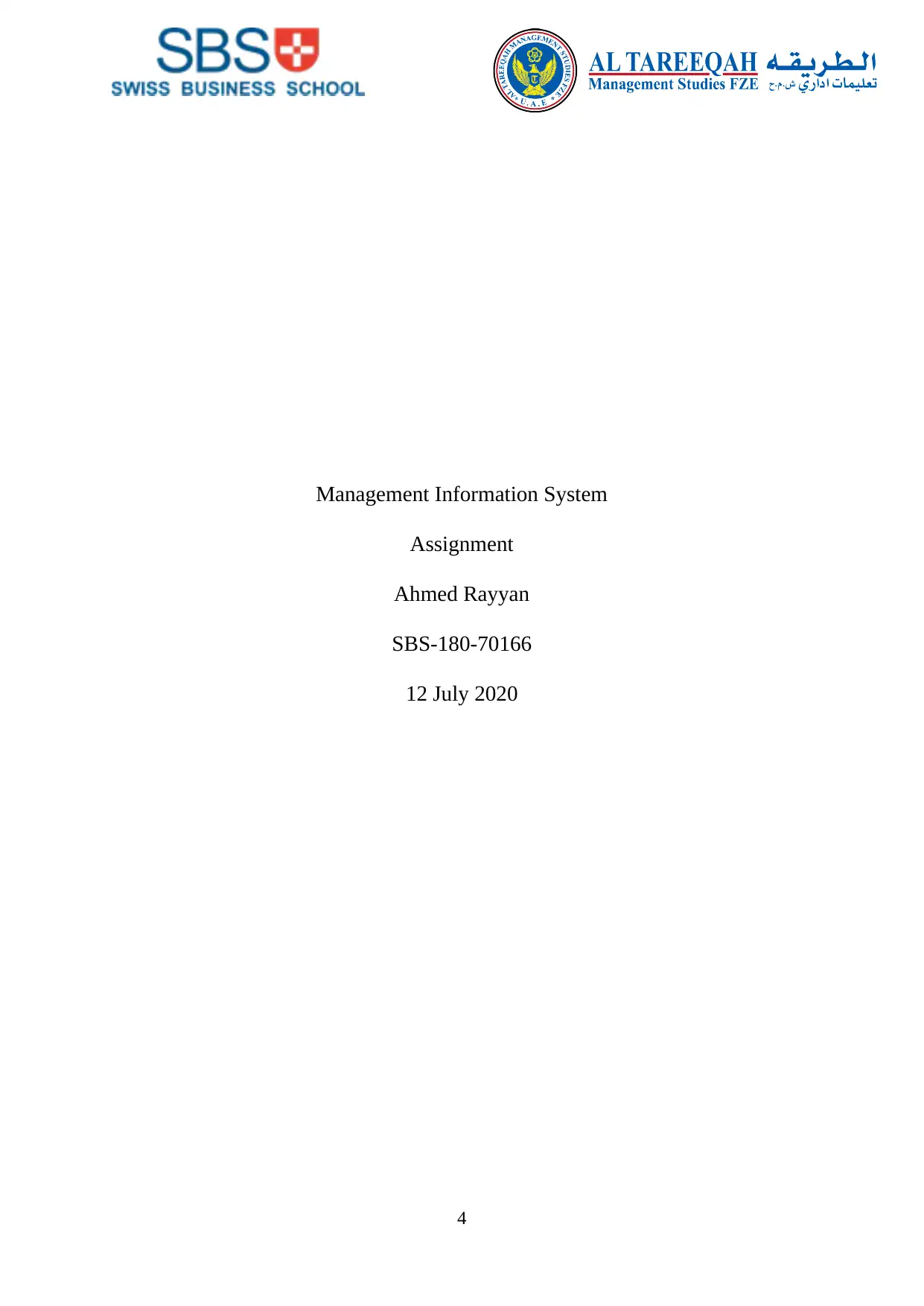
Management Information System
Assignment
Ahmed Rayyan
SBS-180-70166
12 July 2020
4
Assignment
Ahmed Rayyan
SBS-180-70166
12 July 2020
4
Paraphrase This Document
Need a fresh take? Get an instant paraphrase of this document with our AI Paraphraser
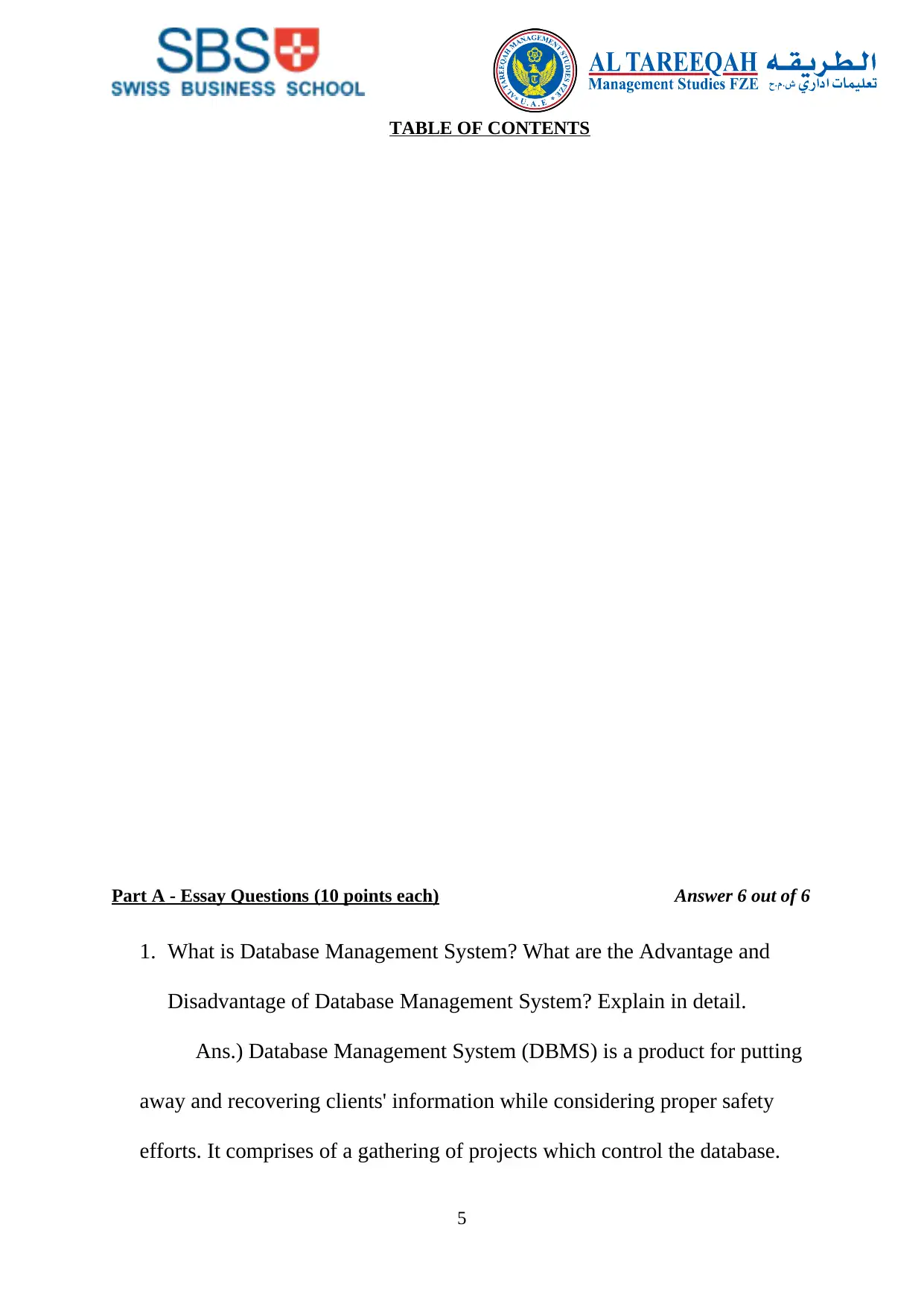
TABLE OF CONTENTS
Part A - Essay Questions (10 points each) Answer 6 out of 6
1. What is Database Management System? What are the Advantage and
Disadvantage of Database Management System? Explain in detail.
Ans.) Database Management System (DBMS) is a product for putting
away and recovering clients' information while considering proper safety
efforts. It comprises of a gathering of projects which control the database.
5
Part A - Essay Questions (10 points each) Answer 6 out of 6
1. What is Database Management System? What are the Advantage and
Disadvantage of Database Management System? Explain in detail.
Ans.) Database Management System (DBMS) is a product for putting
away and recovering clients' information while considering proper safety
efforts. It comprises of a gathering of projects which control the database.
5
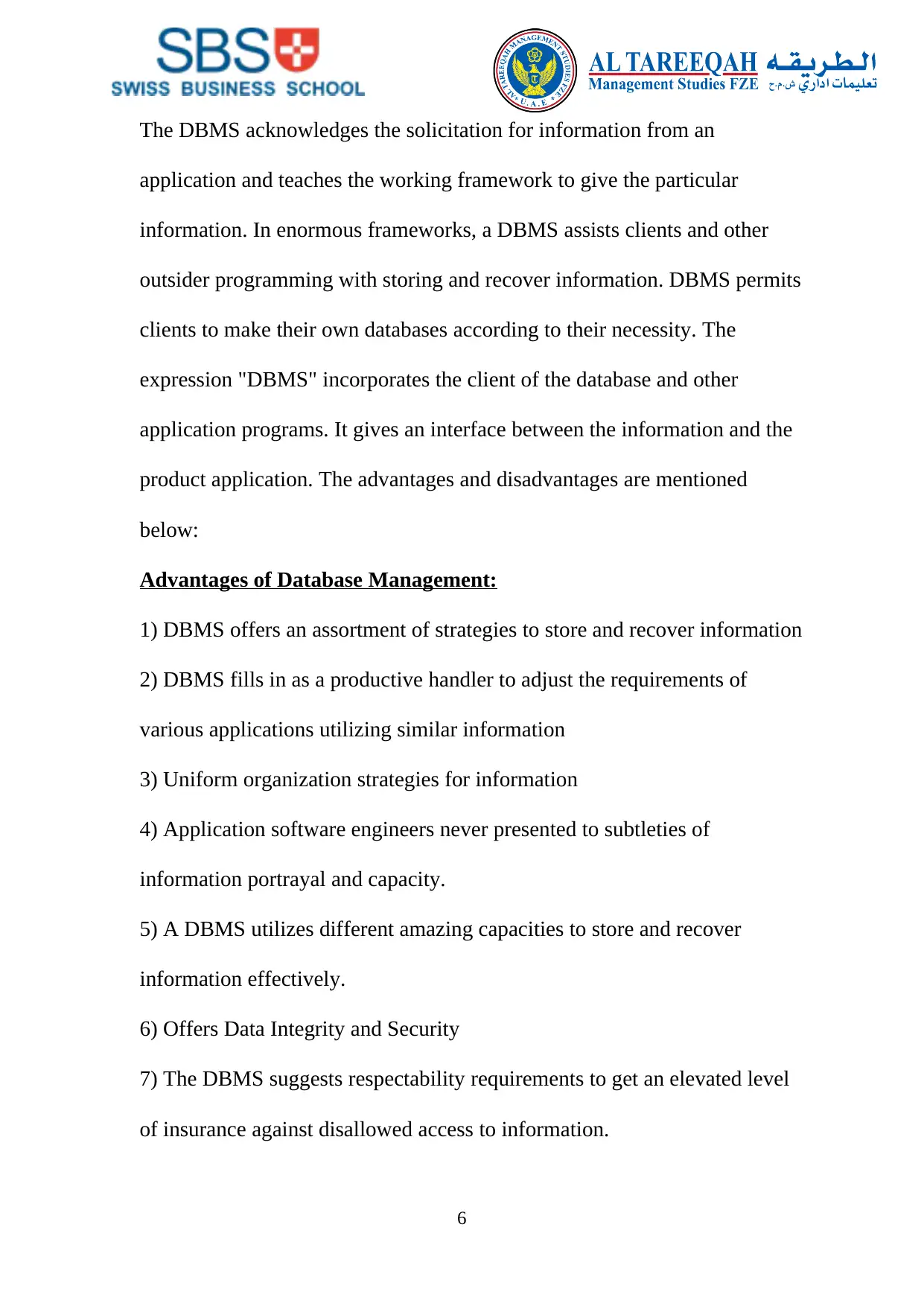
The DBMS acknowledges the solicitation for information from an
application and teaches the working framework to give the particular
information. In enormous frameworks, a DBMS assists clients and other
outsider programming with storing and recover information. DBMS permits
clients to make their own databases according to their necessity. The
expression "DBMS" incorporates the client of the database and other
application programs. It gives an interface between the information and the
product application. The advantages and disadvantages are mentioned
below:
Advantages of Database Management:
1) DBMS offers an assortment of strategies to store and recover information
2) DBMS fills in as a productive handler to adjust the requirements of
various applications utilizing similar information
3) Uniform organization strategies for information
4) Application software engineers never presented to subtleties of
information portrayal and capacity.
5) A DBMS utilizes different amazing capacities to store and recover
information effectively.
6) Offers Data Integrity and Security
7) The DBMS suggests respectability requirements to get an elevated level
of insurance against disallowed access to information.
6
application and teaches the working framework to give the particular
information. In enormous frameworks, a DBMS assists clients and other
outsider programming with storing and recover information. DBMS permits
clients to make their own databases according to their necessity. The
expression "DBMS" incorporates the client of the database and other
application programs. It gives an interface between the information and the
product application. The advantages and disadvantages are mentioned
below:
Advantages of Database Management:
1) DBMS offers an assortment of strategies to store and recover information
2) DBMS fills in as a productive handler to adjust the requirements of
various applications utilizing similar information
3) Uniform organization strategies for information
4) Application software engineers never presented to subtleties of
information portrayal and capacity.
5) A DBMS utilizes different amazing capacities to store and recover
information effectively.
6) Offers Data Integrity and Security
7) The DBMS suggests respectability requirements to get an elevated level
of insurance against disallowed access to information.
6
⊘ This is a preview!⊘
Do you want full access?
Subscribe today to unlock all pages.

Trusted by 1+ million students worldwide
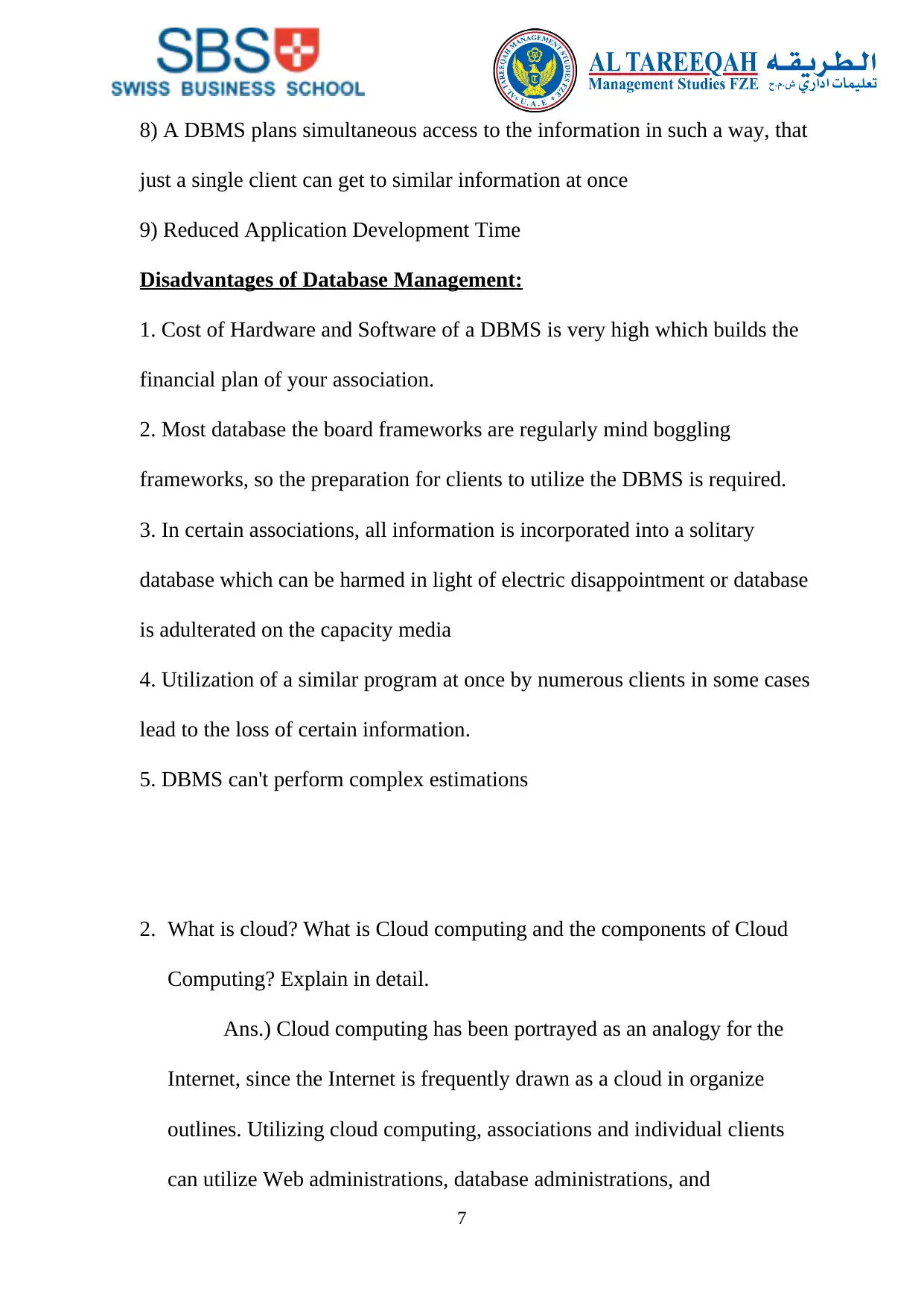
8) A DBMS plans simultaneous access to the information in such a way, that
just a single client can get to similar information at once
9) Reduced Application Development Time
Disadvantages of Database Management:
1. Cost of Hardware and Software of a DBMS is very high which builds the
financial plan of your association.
2. Most database the board frameworks are regularly mind boggling
frameworks, so the preparation for clients to utilize the DBMS is required.
3. In certain associations, all information is incorporated into a solitary
database which can be harmed in light of electric disappointment or database
is adulterated on the capacity media
4. Utilization of a similar program at once by numerous clients in some cases
lead to the loss of certain information.
5. DBMS can't perform complex estimations
2. What is cloud? What is Cloud computing and the components of Cloud
Computing? Explain in detail.
Ans.) Cloud computing has been portrayed as an analogy for the
Internet, since the Internet is frequently drawn as a cloud in organize
outlines. Utilizing cloud computing, associations and individual clients
can utilize Web administrations, database administrations, and
7
just a single client can get to similar information at once
9) Reduced Application Development Time
Disadvantages of Database Management:
1. Cost of Hardware and Software of a DBMS is very high which builds the
financial plan of your association.
2. Most database the board frameworks are regularly mind boggling
frameworks, so the preparation for clients to utilize the DBMS is required.
3. In certain associations, all information is incorporated into a solitary
database which can be harmed in light of electric disappointment or database
is adulterated on the capacity media
4. Utilization of a similar program at once by numerous clients in some cases
lead to the loss of certain information.
5. DBMS can't perform complex estimations
2. What is cloud? What is Cloud computing and the components of Cloud
Computing? Explain in detail.
Ans.) Cloud computing has been portrayed as an analogy for the
Internet, since the Internet is frequently drawn as a cloud in organize
outlines. Utilizing cloud computing, associations and individual clients
can utilize Web administrations, database administrations, and
7
Paraphrase This Document
Need a fresh take? Get an instant paraphrase of this document with our AI Paraphraser
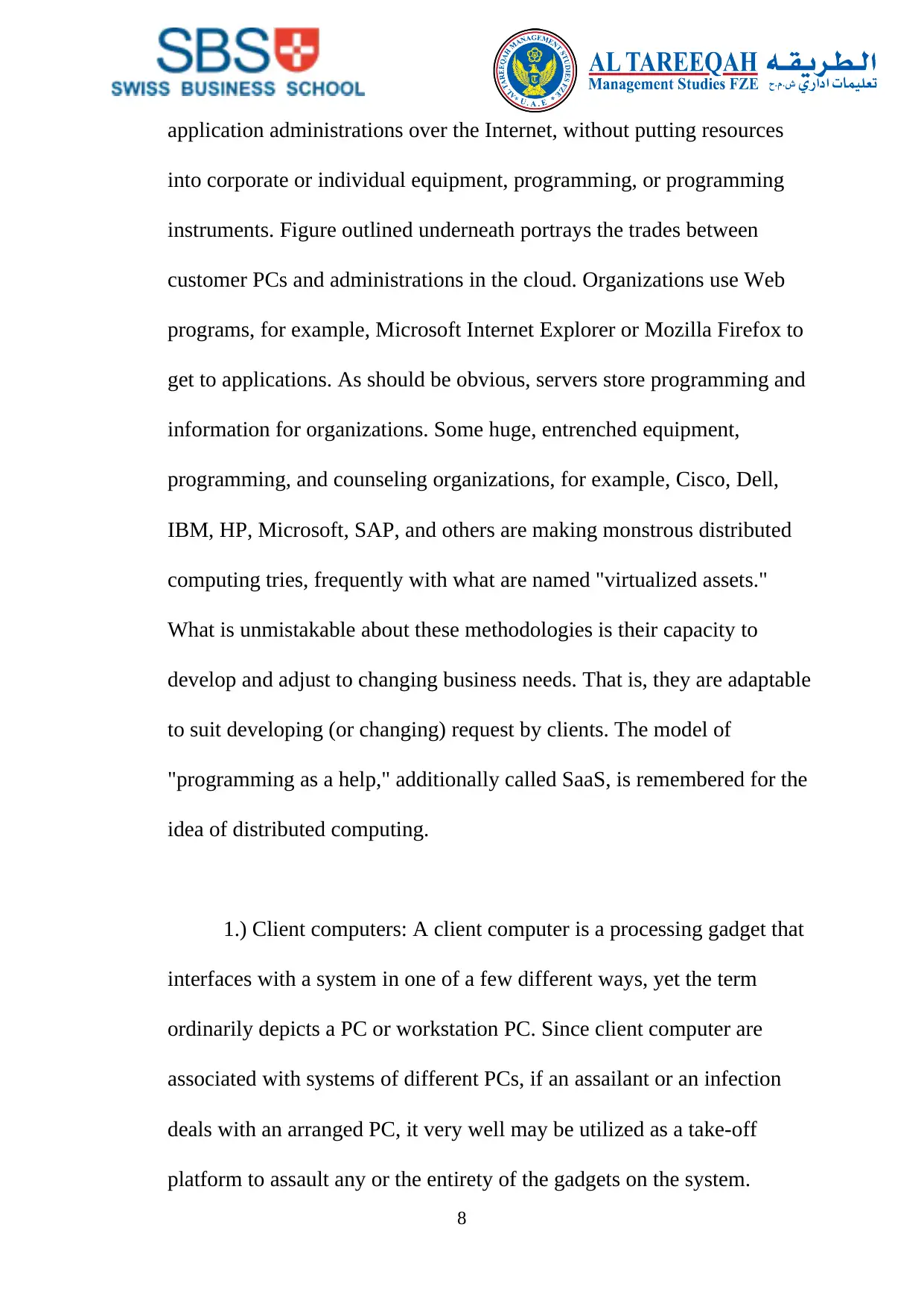
application administrations over the Internet, without putting resources
into corporate or individual equipment, programming, or programming
instruments. Figure outlined underneath portrays the trades between
customer PCs and administrations in the cloud. Organizations use Web
programs, for example, Microsoft Internet Explorer or Mozilla Firefox to
get to applications. As should be obvious, servers store programming and
information for organizations. Some huge, entrenched equipment,
programming, and counseling organizations, for example, Cisco, Dell,
IBM, HP, Microsoft, SAP, and others are making monstrous distributed
computing tries, frequently with what are named "virtualized assets."
What is unmistakable about these methodologies is their capacity to
develop and adjust to changing business needs. That is, they are adaptable
to suit developing (or changing) request by clients. The model of
"programming as a help," additionally called SaaS, is remembered for the
idea of distributed computing.
1.) Client computers: A client computer is a processing gadget that
interfaces with a system in one of a few different ways, yet the term
ordinarily depicts a PC or workstation PC. Since client computer are
associated with systems of different PCs, if an assailant or an infection
deals with an arranged PC, it very well may be utilized as a take-off
platform to assault any or the entirety of the gadgets on the system.
8
into corporate or individual equipment, programming, or programming
instruments. Figure outlined underneath portrays the trades between
customer PCs and administrations in the cloud. Organizations use Web
programs, for example, Microsoft Internet Explorer or Mozilla Firefox to
get to applications. As should be obvious, servers store programming and
information for organizations. Some huge, entrenched equipment,
programming, and counseling organizations, for example, Cisco, Dell,
IBM, HP, Microsoft, SAP, and others are making monstrous distributed
computing tries, frequently with what are named "virtualized assets."
What is unmistakable about these methodologies is their capacity to
develop and adjust to changing business needs. That is, they are adaptable
to suit developing (or changing) request by clients. The model of
"programming as a help," additionally called SaaS, is remembered for the
idea of distributed computing.
1.) Client computers: A client computer is a processing gadget that
interfaces with a system in one of a few different ways, yet the term
ordinarily depicts a PC or workstation PC. Since client computer are
associated with systems of different PCs, if an assailant or an infection
deals with an arranged PC, it very well may be utilized as a take-off
platform to assault any or the entirety of the gadgets on the system.
8
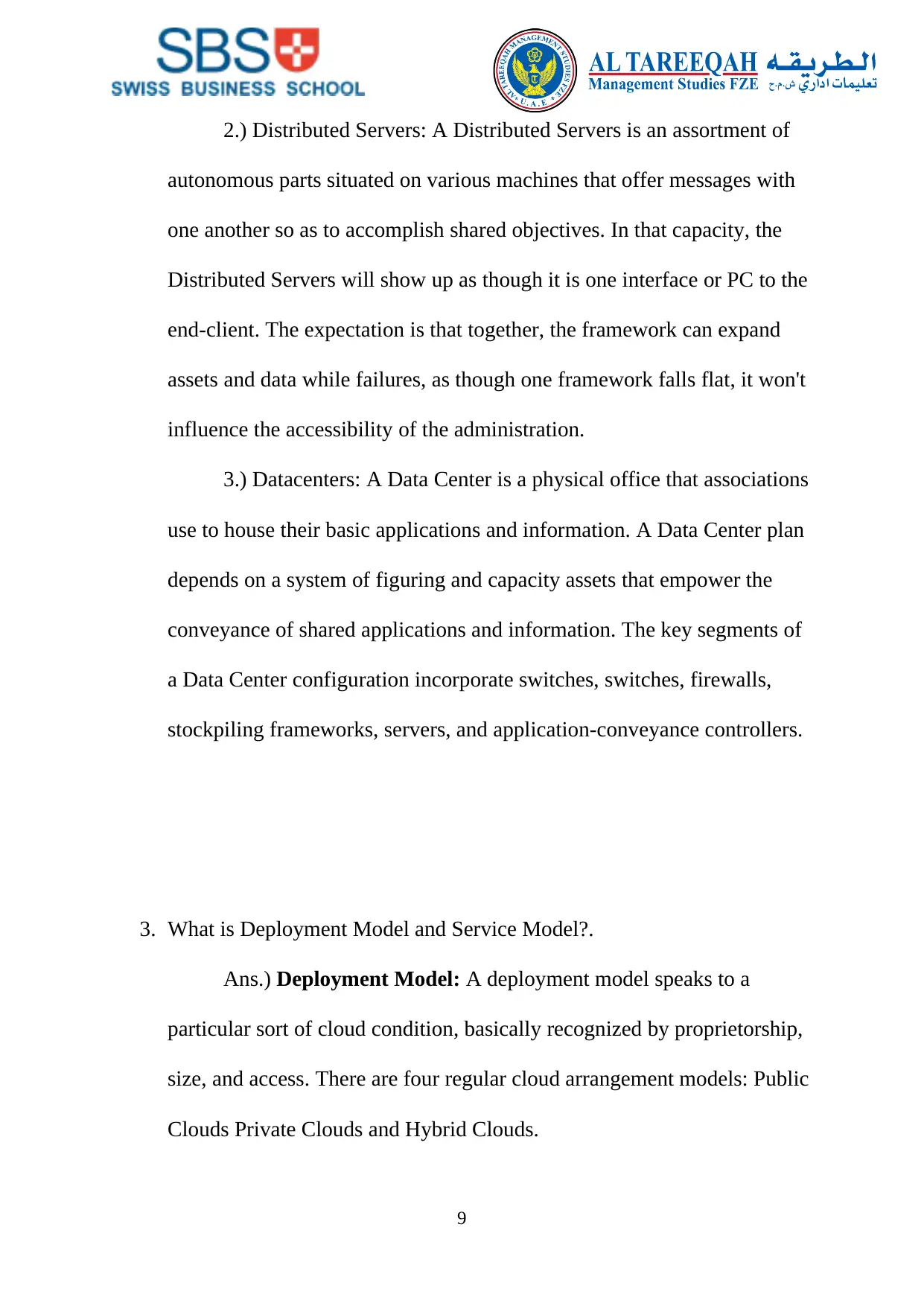
2.) Distributed Servers: A Distributed Servers is an assortment of
autonomous parts situated on various machines that offer messages with
one another so as to accomplish shared objectives. In that capacity, the
Distributed Servers will show up as though it is one interface or PC to the
end-client. The expectation is that together, the framework can expand
assets and data while failures, as though one framework falls flat, it won't
influence the accessibility of the administration.
3.) Datacenters: A Data Center is a physical office that associations
use to house their basic applications and information. A Data Center plan
depends on a system of figuring and capacity assets that empower the
conveyance of shared applications and information. The key segments of
a Data Center configuration incorporate switches, switches, firewalls,
stockpiling frameworks, servers, and application-conveyance controllers.
3. What is Deployment Model and Service Model?.
Ans.) Deployment Model: A deployment model speaks to a
particular sort of cloud condition, basically recognized by proprietorship,
size, and access. There are four regular cloud arrangement models: Public
Clouds Private Clouds and Hybrid Clouds.
9
autonomous parts situated on various machines that offer messages with
one another so as to accomplish shared objectives. In that capacity, the
Distributed Servers will show up as though it is one interface or PC to the
end-client. The expectation is that together, the framework can expand
assets and data while failures, as though one framework falls flat, it won't
influence the accessibility of the administration.
3.) Datacenters: A Data Center is a physical office that associations
use to house their basic applications and information. A Data Center plan
depends on a system of figuring and capacity assets that empower the
conveyance of shared applications and information. The key segments of
a Data Center configuration incorporate switches, switches, firewalls,
stockpiling frameworks, servers, and application-conveyance controllers.
3. What is Deployment Model and Service Model?.
Ans.) Deployment Model: A deployment model speaks to a
particular sort of cloud condition, basically recognized by proprietorship,
size, and access. There are four regular cloud arrangement models: Public
Clouds Private Clouds and Hybrid Clouds.
9
⊘ This is a preview!⊘
Do you want full access?
Subscribe today to unlock all pages.

Trusted by 1+ million students worldwide
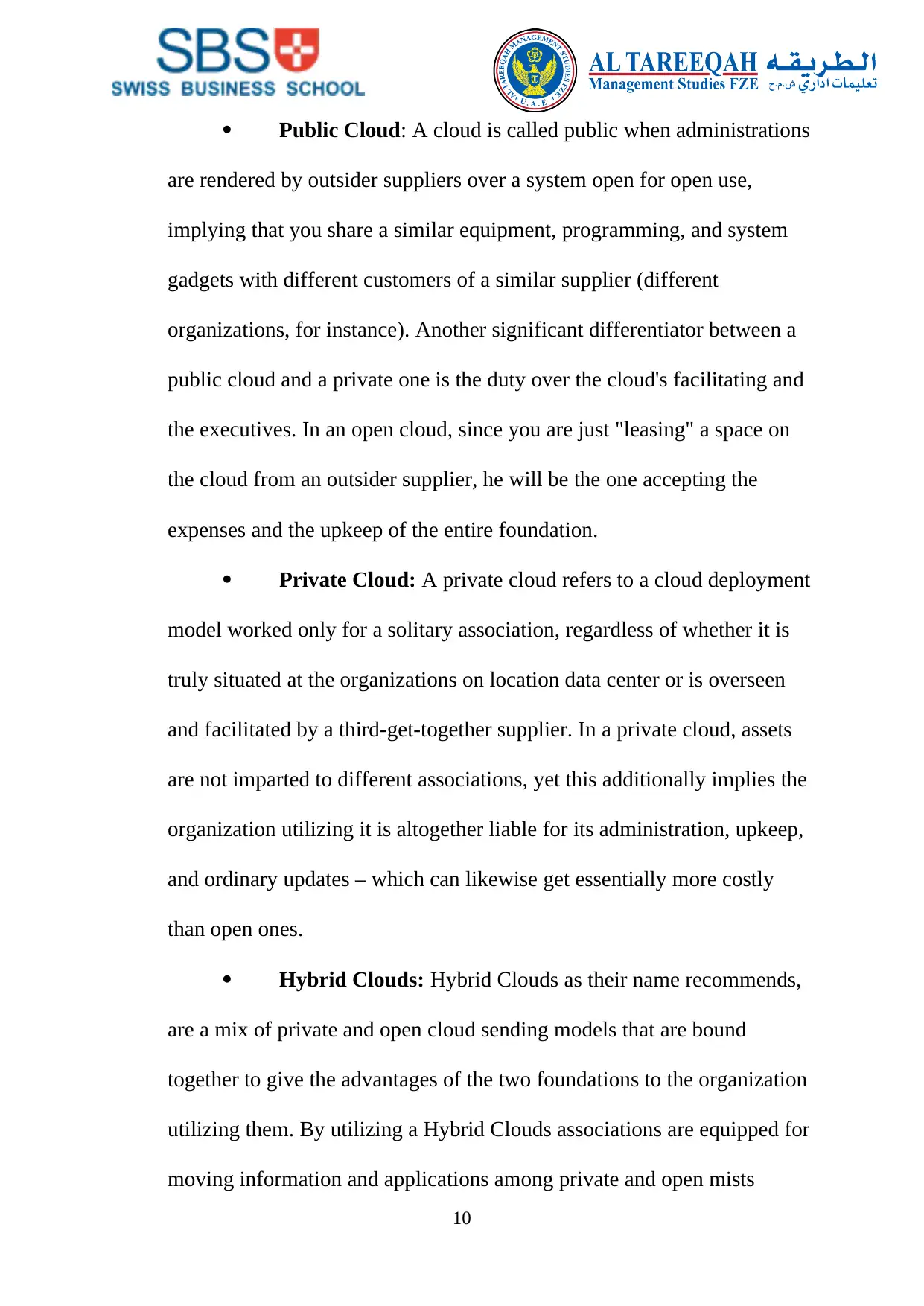
Public Cloud: A cloud is called public when administrations
are rendered by outsider suppliers over a system open for open use,
implying that you share a similar equipment, programming, and system
gadgets with different customers of a similar supplier (different
organizations, for instance). Another significant differentiator between a
public cloud and a private one is the duty over the cloud's facilitating and
the executives. In an open cloud, since you are just "leasing" a space on
the cloud from an outsider supplier, he will be the one accepting the
expenses and the upkeep of the entire foundation.
Private Cloud: A private cloud refers to a cloud deployment
model worked only for a solitary association, regardless of whether it is
truly situated at the organizations on location data center or is overseen
and facilitated by a third-get-together supplier. In a private cloud, assets
are not imparted to different associations, yet this additionally implies the
organization utilizing it is altogether liable for its administration, upkeep,
and ordinary updates – which can likewise get essentially more costly
than open ones.
Hybrid Clouds: Hybrid Clouds as their name recommends,
are a mix of private and open cloud sending models that are bound
together to give the advantages of the two foundations to the organization
utilizing them. By utilizing a Hybrid Clouds associations are equipped for
moving information and applications among private and open mists
10
are rendered by outsider suppliers over a system open for open use,
implying that you share a similar equipment, programming, and system
gadgets with different customers of a similar supplier (different
organizations, for instance). Another significant differentiator between a
public cloud and a private one is the duty over the cloud's facilitating and
the executives. In an open cloud, since you are just "leasing" a space on
the cloud from an outsider supplier, he will be the one accepting the
expenses and the upkeep of the entire foundation.
Private Cloud: A private cloud refers to a cloud deployment
model worked only for a solitary association, regardless of whether it is
truly situated at the organizations on location data center or is overseen
and facilitated by a third-get-together supplier. In a private cloud, assets
are not imparted to different associations, yet this additionally implies the
organization utilizing it is altogether liable for its administration, upkeep,
and ordinary updates – which can likewise get essentially more costly
than open ones.
Hybrid Clouds: Hybrid Clouds as their name recommends,
are a mix of private and open cloud sending models that are bound
together to give the advantages of the two foundations to the organization
utilizing them. By utilizing a Hybrid Clouds associations are equipped for
moving information and applications among private and open mists
10
Paraphrase This Document
Need a fresh take? Get an instant paraphrase of this document with our AI Paraphraser
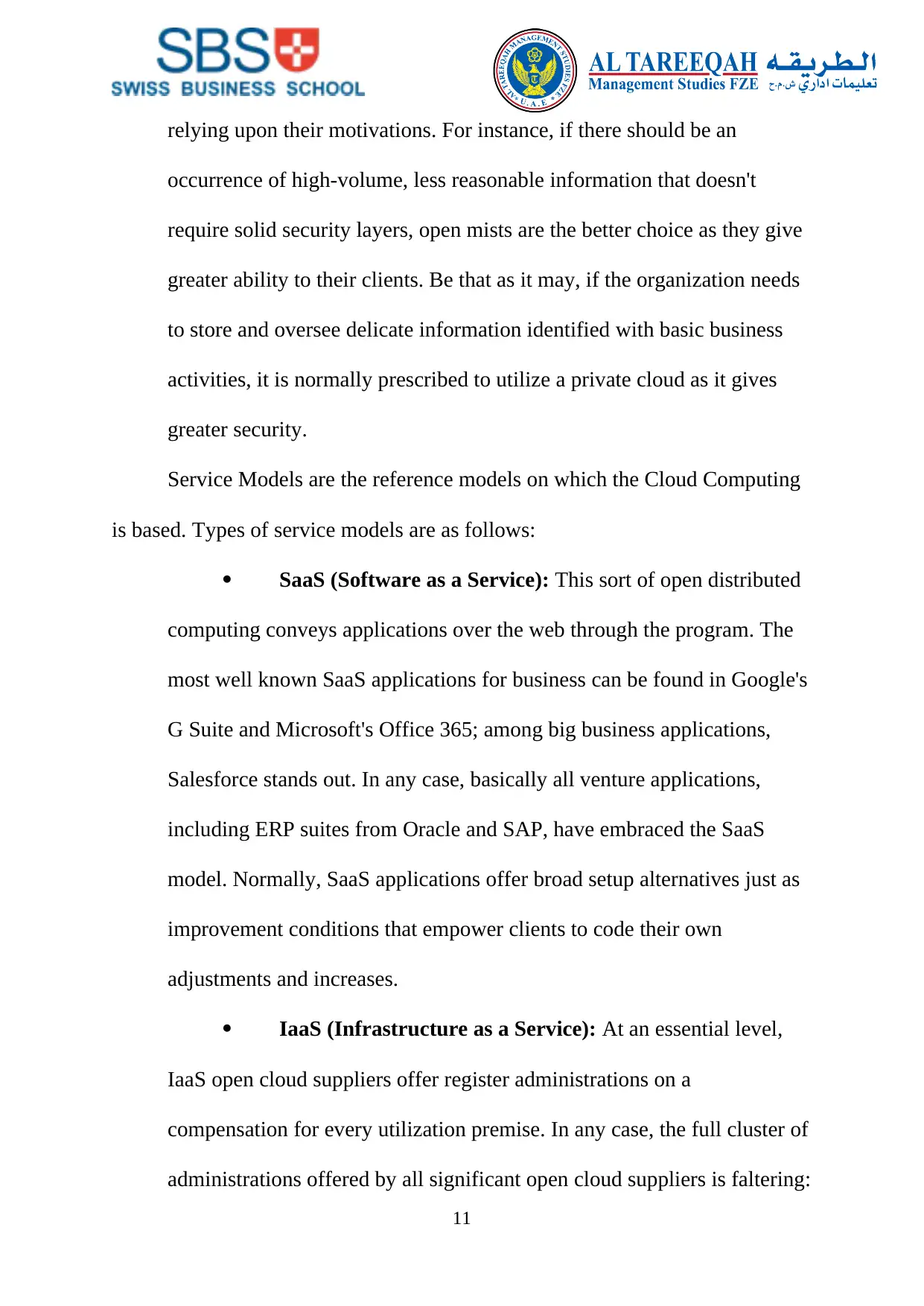
relying upon their motivations. For instance, if there should be an
occurrence of high-volume, less reasonable information that doesn't
require solid security layers, open mists are the better choice as they give
greater ability to their clients. Be that as it may, if the organization needs
to store and oversee delicate information identified with basic business
activities, it is normally prescribed to utilize a private cloud as it gives
greater security.
Service Models are the reference models on which the Cloud Computing
is based. Types of service models are as follows:
SaaS (Software as a Service): This sort of open distributed
computing conveys applications over the web through the program. The
most well known SaaS applications for business can be found in Google's
G Suite and Microsoft's Office 365; among big business applications,
Salesforce stands out. In any case, basically all venture applications,
including ERP suites from Oracle and SAP, have embraced the SaaS
model. Normally, SaaS applications offer broad setup alternatives just as
improvement conditions that empower clients to code their own
adjustments and increases.
IaaS (Infrastructure as a Service): At an essential level,
IaaS open cloud suppliers offer register administrations on a
compensation for every utilization premise. In any case, the full cluster of
administrations offered by all significant open cloud suppliers is faltering:
11
occurrence of high-volume, less reasonable information that doesn't
require solid security layers, open mists are the better choice as they give
greater ability to their clients. Be that as it may, if the organization needs
to store and oversee delicate information identified with basic business
activities, it is normally prescribed to utilize a private cloud as it gives
greater security.
Service Models are the reference models on which the Cloud Computing
is based. Types of service models are as follows:
SaaS (Software as a Service): This sort of open distributed
computing conveys applications over the web through the program. The
most well known SaaS applications for business can be found in Google's
G Suite and Microsoft's Office 365; among big business applications,
Salesforce stands out. In any case, basically all venture applications,
including ERP suites from Oracle and SAP, have embraced the SaaS
model. Normally, SaaS applications offer broad setup alternatives just as
improvement conditions that empower clients to code their own
adjustments and increases.
IaaS (Infrastructure as a Service): At an essential level,
IaaS open cloud suppliers offer register administrations on a
compensation for every utilization premise. In any case, the full cluster of
administrations offered by all significant open cloud suppliers is faltering:
11
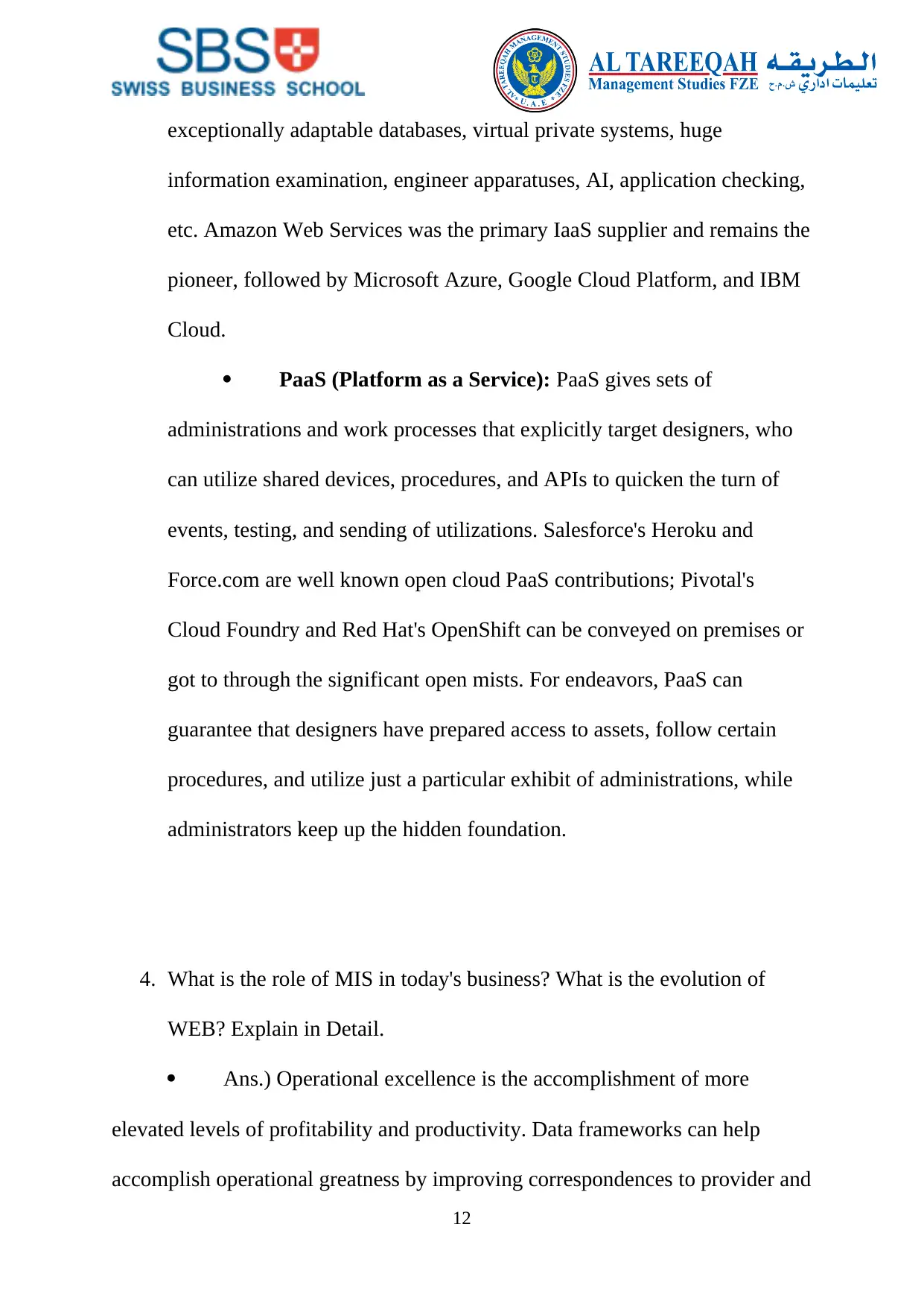
exceptionally adaptable databases, virtual private systems, huge
information examination, engineer apparatuses, AI, application checking,
etc. Amazon Web Services was the primary IaaS supplier and remains the
pioneer, followed by Microsoft Azure, Google Cloud Platform, and IBM
Cloud.
PaaS (Platform as a Service): PaaS gives sets of
administrations and work processes that explicitly target designers, who
can utilize shared devices, procedures, and APIs to quicken the turn of
events, testing, and sending of utilizations. Salesforce's Heroku and
Force.com are well known open cloud PaaS contributions; Pivotal's
Cloud Foundry and Red Hat's OpenShift can be conveyed on premises or
got to through the significant open mists. For endeavors, PaaS can
guarantee that designers have prepared access to assets, follow certain
procedures, and utilize just a particular exhibit of administrations, while
administrators keep up the hidden foundation.
4. What is the role of MIS in today's business? What is the evolution of
WEB? Explain in Detail.
Ans.) Operational excellence is the accomplishment of more
elevated levels of profitability and productivity. Data frameworks can help
accomplish operational greatness by improving correspondences to provider and
12
information examination, engineer apparatuses, AI, application checking,
etc. Amazon Web Services was the primary IaaS supplier and remains the
pioneer, followed by Microsoft Azure, Google Cloud Platform, and IBM
Cloud.
PaaS (Platform as a Service): PaaS gives sets of
administrations and work processes that explicitly target designers, who
can utilize shared devices, procedures, and APIs to quicken the turn of
events, testing, and sending of utilizations. Salesforce's Heroku and
Force.com are well known open cloud PaaS contributions; Pivotal's
Cloud Foundry and Red Hat's OpenShift can be conveyed on premises or
got to through the significant open mists. For endeavors, PaaS can
guarantee that designers have prepared access to assets, follow certain
procedures, and utilize just a particular exhibit of administrations, while
administrators keep up the hidden foundation.
4. What is the role of MIS in today's business? What is the evolution of
WEB? Explain in Detail.
Ans.) Operational excellence is the accomplishment of more
elevated levels of profitability and productivity. Data frameworks can help
accomplish operational greatness by improving correspondences to provider and
12
⊘ This is a preview!⊘
Do you want full access?
Subscribe today to unlock all pages.

Trusted by 1+ million students worldwide
1 out of 19
Related Documents
Your All-in-One AI-Powered Toolkit for Academic Success.
+13062052269
info@desklib.com
Available 24*7 on WhatsApp / Email
![[object Object]](/_next/static/media/star-bottom.7253800d.svg)
Unlock your academic potential
Copyright © 2020–2025 A2Z Services. All Rights Reserved. Developed and managed by ZUCOL.




